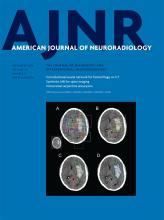Index by author
Yoon, B.C.
- FELLOWS' JOURNAL CLUBAdult BrainYou have accessEvaluation of Thick-Slab Overlapping MIP Images of Contrast-Enhanced 3D T1-Weighted CUBE for Detection of Intracranial Metastases: A Pilot Study for Comparison of Lesion Detection, Interpretation Time, and Sensitivity with Nonoverlapping CUBE MIP, CUBE, and Inversion-Recovery-Prepared Fast-Spoiled Gradient Recalled Brain VolumeB.C. Yoon, A.F. Saad, P. Rezaii, M. Wintermark, G. Zaharchuk and M. IvAmerican Journal of Neuroradiology September 2018, 39 (9) 1635-1642; DOI: https://doi.org/10.3174/ajnr.A5747
The authors performed a retrospective review of 48 patients with cerebral metastases from June 2016 to October 2017. Brain MRIs included gadolinium-enhanced T1-weighted IR-FSPGR-BRAVO and CUBE, with subsequent generation of nonoverlapping CUBE MIP and overlapping CUBE MIP. Two blinded radiologists identified the total number and location of metastases on each image type. This study suggests that the use of overlapping CUBE MIP or nonoverlapping CUBE MIP for the detection of brain metastases can reduce interpretation time without sacrificing sensitivity, though the contrast-to-noise ratio of lesions is highest for overlapping CUBE MIP.
Young, J.R.
- Patient SafetyYou have accessGadolinium Deposition within the Pediatric Brain: No Increased Intrinsic T1-Weighted Signal Intensity within the Dentate Nucleus following the Administration of a Minimum of 4 Doses of the Macrocyclic Agent GadoteridolJ.R. Young, W.B. Pope and M. BobinskiAmerican Journal of Neuroradiology September 2018, 39 (9) 1604-1608; DOI: https://doi.org/10.3174/ajnr.A5748
Yu, M.-M.
- Adult BrainOpen AccessLongitudinal Microstructural Changes in Traumatic Brain Injury in Rats: A Diffusional Kurtosis Imaging, Histology, and Behavior StudyM.-L. Wang, M.-M. Yu, D.-X. Yang, Y.-L. Liu, X.-E. Wei and W.-B. LiAmerican Journal of Neuroradiology September 2018, 39 (9) 1650-1656; DOI: https://doi.org/10.3174/ajnr.A5737
Yu, W.
- EDITOR'S CHOICEAdult BrainOpen AccessHybrid 3D/2D Convolutional Neural Network for Hemorrhage Evaluation on Head CTP.D. Chang, E. Kuoy, J. Grinband, B.D. Weinberg, M. Thompson, R. Homo, J. Chen, H. Abcede, M. Shafie, L. Sugrue, C.G. Filippi, M.-Y. Su, W. Yu, C. Hess and D. ChowAmerican Journal of Neuroradiology September 2018, 39 (9) 1609-1616; DOI: https://doi.org/10.3174/ajnr.A5742
This study evaluates a convolutional neural network optimized for the detection and quantification of intraparenchymal, epidural/subdural, and subarachnoid hemorrhages on noncontrast CT with a 10,159-examination training cohort (512,598 images; 901/8.1% hemorrhages) and an 862-examination test cohort (23,668 images; 82/12% hemorrhages). Accuracy, area under the curve, sensitivity, specificity, positive predictive value, and negative predictive value for hemorrhage detection were 0.975, 0.983, 0.971, 0.975, 0.793, and 0.997 on training cohort cross-validation and 0.970, 0.981, 0.951, 0.973, 0.829, and 0.993 for the prospective test set.
Yushkevich, P.
- EDITOR'S CHOICEAdult BrainOpen AccessQuantitative MRI of Perivascular Spaces at 3T for Early Diagnosis of Mild Cognitive ImpairmentM. Niazi, M. Karaman, S. Das, X.J. Zhou, P. Yushkevich and K. CaiAmerican Journal of Neuroradiology September 2018, 39 (9) 1622-1628; DOI: https://doi.org/10.3174/ajnr.A5734
The authors automated the identification of enlarged perivascular spaces in brain MR images using a custom quantitative program designed with Matlab. They quantified the densities of enlarged perivascular spaces for patients with mild cognitive impairment (n=14) and age-matched cognitively healthy controls (n=15) and compared them to determine whether the density of enlarged perivascular spaces can serve as an imaging surrogate for mild cognitive impairment diagnosis. The density of enlarged perivascular spaces was found to be significantly higher in those with mild cognitive impairment compared with age-matched healthy control subjects.
Zaharchuk, G.
- FELLOWS' JOURNAL CLUBAdult BrainYou have accessEvaluation of Thick-Slab Overlapping MIP Images of Contrast-Enhanced 3D T1-Weighted CUBE for Detection of Intracranial Metastases: A Pilot Study for Comparison of Lesion Detection, Interpretation Time, and Sensitivity with Nonoverlapping CUBE MIP, CUBE, and Inversion-Recovery-Prepared Fast-Spoiled Gradient Recalled Brain VolumeB.C. Yoon, A.F. Saad, P. Rezaii, M. Wintermark, G. Zaharchuk and M. IvAmerican Journal of Neuroradiology September 2018, 39 (9) 1635-1642; DOI: https://doi.org/10.3174/ajnr.A5747
The authors performed a retrospective review of 48 patients with cerebral metastases from June 2016 to October 2017. Brain MRIs included gadolinium-enhanced T1-weighted IR-FSPGR-BRAVO and CUBE, with subsequent generation of nonoverlapping CUBE MIP and overlapping CUBE MIP. Two blinded radiologists identified the total number and location of metastases on each image type. This study suggests that the use of overlapping CUBE MIP or nonoverlapping CUBE MIP for the detection of brain metastases can reduce interpretation time without sacrificing sensitivity, though the contrast-to-noise ratio of lesions is highest for overlapping CUBE MIP.
Zhou, W.
- Head & NeckOpen AccessComparison of a Photon-Counting-Detector CT with an Energy-Integrating-Detector CT for Temporal Bone Imaging: A Cadaveric StudyW. Zhou, J.I. Lane, M.L. Carlson, M.R. Bruesewitz, R.J. Witte, K.K. Koeller, L.J. Eckel, R.E. Carter, C.H. McCollough and S. LengAmerican Journal of Neuroradiology September 2018, 39 (9) 1733-1738; DOI: https://doi.org/10.3174/ajnr.A5768
Zhou, X.J.
- EDITOR'S CHOICEAdult BrainOpen AccessQuantitative MRI of Perivascular Spaces at 3T for Early Diagnosis of Mild Cognitive ImpairmentM. Niazi, M. Karaman, S. Das, X.J. Zhou, P. Yushkevich and K. CaiAmerican Journal of Neuroradiology September 2018, 39 (9) 1622-1628; DOI: https://doi.org/10.3174/ajnr.A5734
The authors automated the identification of enlarged perivascular spaces in brain MR images using a custom quantitative program designed with Matlab. They quantified the densities of enlarged perivascular spaces for patients with mild cognitive impairment (n=14) and age-matched cognitively healthy controls (n=15) and compared them to determine whether the density of enlarged perivascular spaces can serve as an imaging surrogate for mild cognitive impairment diagnosis. The density of enlarged perivascular spaces was found to be significantly higher in those with mild cognitive impairment compared with age-matched healthy control subjects.
Zivadinov, R.
- Extracranial VascularOpen AccessFive-Year Longitudinal Study of Neck Vessel Cross-Sectional Area in Multiple SclerosisL. Pelizzari, D. Jakimovski, M.M. Laganà, N. Bergsland, J. Hagemeier, G. Baselli, B. Weinstock-Guttman and R. ZivadinovAmerican Journal of Neuroradiology September 2018, 39 (9) 1703-1709; DOI: https://doi.org/10.3174/ajnr.A5738
Zuccoli, G.
- PediatricsYou have accessTime Course of Cerebral Perfusion Changes in Children with Migraine with Aura Mimicking StrokeK.M. Cobb-Pitstick, N. Munjal, R. Safier, D.D. Cummings and G. ZuccoliAmerican Journal of Neuroradiology September 2018, 39 (9) 1751-1755; DOI: https://doi.org/10.3174/ajnr.A5693








